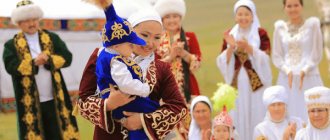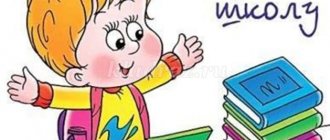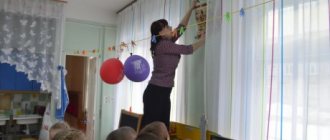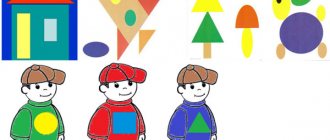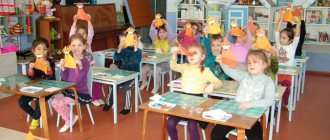An excursion as a form of introducing children to the history and sights of their native area
One of the main tasks of educating preschoolers facing the teacher at the present stage is to instill in preschoolers a love for the Motherland, their native land, and a sense of pride in their Motherland. Children's performance begins with a picture, the music the child hears, the nature around him, and the life of familiar streets. Year after year it expands, enriches, and improves. The use of local local history material in the educational process is of great importance for the formation, expansion and deepening of ideas about the native land, patriotic feelings, and instilling love for the native land. It is useful to introduce preschoolers to the successes of their native land, since local history information is closer and more understandable to them and arouses their cognitive interest. The use of local history material in the educational process in a preschool institution undoubtedly plays a big role in the formation of children’s national self-awareness.
Introducing preschoolers to their hometown and home country is a long and complex process. The need to develop the interests of preschoolers in this area is connected with the social demand of society; the more complete, deeper, and more meaningful the children’s knowledge about their native land and its best people, nature, and traditions, the more effective they will be in nurturing love for their area.
Therefore, there is a very high need to organize an excursion around the native area in order to get acquainted with the history of the native area, for this we used the following methods:
— held conversations about the history of their native region;
- looked at photographs;
— developed and conducted excursions.
An excursion is a form of educational activity that allows you to organize observations and changes in objects, objects and phenomena in natural conditions. Excursions help to concretize existing knowledge, provide new ones, and increase interest in what is being studied. Walks and excursions are one of the most important organized activities, during which a love and aesthetic attitude towards nature is fostered, the child’s cognitive needs are satisfied, and motor skills and physical qualities are improved, i.e. health problems are fully solved. During thematic excursions, the child gets his first ideas about his homeland, his region. Excursions provide an opportunity to introduce children to new material in a natural setting.
During the excursion work the following tasks are solved:
- identifying the level of formation of ideas about the native area;
— formation in children of a system of knowledge about their area;
— nurturing preschoolers’ interest in the world around them;
— acquaintance with the sights of the area, with the people who have made their area famous.
One of the types of excursions is educational health paths.
Educational health paths are specially designed routes for children through the territory of a preschool educational institution, outside the kindergarten, to parks, squares with visits to play areas on the asphalt, centers of educational and research activities, environmental and health trails.
The purpose of the educational health path is to improve the health of students’ bodies, increase the level of motor activity, and cognitive and research activities of children and adults.
The route of the health path is divided into several “stations”, which have their own name and distinctive features.
The content of the path depends on the chosen topic, time of year, and weather.
In our garden, we have developed a rough plan for excursions for senior and preparatory groups:
For older groups:
— Excursion “Educational health path” around the microdistrict.
— A local history museum to familiarize children with the historical and cultural heritage of our city.
— Gogol Library for an introductory tour.
— Museum “Russian Izba” at school No. 18 with familiarization with ethnographic material.
— Excursion to the Obelisk, erected in memory of the workers of the Tochmash plant who died during the Second World War.
— Excursion to the monument to home front workers near school No. 178.
For preparatory groups
Thematic excursions to the library named after. Gogol on May 9 and dedicated to the history of the city of Novosibirsk.
— School No. 18 (Museum of Military Glory) with an introduction to exhibits collected by students and school staff dedicated to the Second World War.
— School No. 82, (museum of military glory) where during the Second World War there was a hospital for those wounded in combat during the Second World War.
— Monument of Glory to instill patriotic feelings among students.
— Monument to those who died in hospitals from wounds in Birch Grove Park
— Excursion to the fire station to get acquainted with fire engines, special clothing, fire and rescue equipment.
- Excursion to the Autotown" excursion during which children became familiar with the rules of the road, becoming direct participants in this traffic.
— Excursion to the Museum of History of the Dzerzhinsky District.
Immediately after the excursion, conversations were held with the children, during which they used the material they brought with them. We listened to and wrote down the children's stories. Together with them we came up with environmental fairy tales. And the children reflected their emotional impressions in drawings, collages, and collective works. We compiled this material into albums and little books. All this activity contributed to the generalization of information, children’s impressions of the excursion, and reflection.
Excursions create powerful motivation in children to explore their native land, develop a sense of pride in children and provide the emotional background against which the assimilation of quite complex information occurs easily and naturally.
The main task of the preschool education system here is to prevent indifference among our children and to ignite sparks of love for the Motherland.
As practice shows, the most memorable and effective are such forms and methods of work in local history, where children themselves were active participants, where visualization was widely used, therefore the development and conduct of such events in preschool institutions as excursions becomes especially relevant in modern conditions.
“I’ll take you to a museum!”: 7 museums worth visiting with children
Museum of Entertaining Sciences "Experimentanium"
Address : Leningradsky pr-t., 80, room 11
Who would you like to be? 5 modern professions that you can try on at school
"Experimentanium" will help to interest children in science - after all, it is presented in the form of interactive objects with which they can and should interact: collect educational "constructors", solve riddles and touch all sorts of exhibits. Jumping and screaming are allowed!
Each room is dedicated to its own theme: sound, optics, magnetism, electricity, water, puzzles, mechanics and space. Together with your child, you will find out whether a shadow can be colored, how to light a light bulb with your ear, how a gateway and a water mill work, what a rocket and an octopus have in common. You will also conduct entertaining experiments to determine how much easier mechanical inventions make life.
Museum of Nomadic Culture
Address : st. Aviamotornaya, 30A, building 1
Northern fairy tale: where to pet the deer and husky
In the museum of nomadic culture you can learn how different peoples of the world live: study the northern tent or the tent of the desert nomads, listen to songs and fairy tales to the sounds of the Mongolian bowed instrument morinkhur or the Kazakh folk dombra.
And also play national games, solve riddles, developing your ingenuity. All exhibits are displayed not under glass, but in nomadic dwellings, where there are no strict prohibitions on touching something with your hands. The museum is open by appointment; it hosts both thematic excursions, lectures, and concerts; announcements of events are published in the VKontakte group.
Museum-Theater "Fairy Tale House"
Address : st. Auto
14 cool children's book publishers
The Fairytale House Museum-Theater introduces visitors to the objects of the fairy-tale world and Old Russian life through interactive performances based on Russian and foreign fairy tales.
The guys are actively involved in the productions: they help the main characters make the right and fair decision, suggesting what is best to do so that good wins. Each item in the Fairytale House can be rotated, moved and viewed from all sides. The playbill for February includes the performances “The Golden Key”, “The Three Little Pigs”, “Kolobok”, “The Canterville Ghost”, “Masha and the Bear” and many others.
Automobile History Museum
Address : st. Koptevskaya, 71
Principles of natural learning: safety, non-judgment, biology
The Museum of Automotive History houses a small motor town with rubberized roads and markings, artificial turf, pedestrian crossings with traffic lights and road signs.
Children are taught the rules of the road in a playful way, and then they put their knowledge into practice: they get behind the wheel of pedal cars, each of which has its own story - after all, they are museum exhibits! Also, children with their parents can take a tour “Soviet-made pedal cars” and look into a real service workshop to learn more about the structure of the cars and see how they are repaired.
Museum of Unique Dolls
Address : st. Pokrovka, 13, building 2
Hello, darkness. Why visit scary dolls?
The museum's holdings of unique dolls include about 6,000 exhibits: porcelain, wax, textile and wooden toys created by craftsmen from different countries in the late 17th - early 20th centuries.
There are also movie stars in the collection - for example, Suok, the doll of the heir Tutti from the film “Three Fat Men” or the more modern heroine of the “Doll” video “Ivanushek International”. It is also interesting to look at how the toy beauties were dressed up: clothes, shoes, even hats, umbrellas and jewelry emphasize the way of life and traditions of that time. And, of course, admire the doll houses furnished with miniature furniture. They are made in different architectural styles - for example, "English town house" and "Tudor" style house.
Space Museum
Address : Mira Ave., 111
Go! 24 songs about space
Now, of course, not every child dreams of becoming an astronaut, but thoughts about the first flight beyond the Earth, rockets and distant planets will still not leave anyone indifferent.
At the Museum of Cosmonautics you can learn more about this topic by looking at the unusual exhibits housed in 8 halls. For example, automatic stations and the first artificial Earth satellite are waiting for you in the “Morning of the Space Age” hall or spacesuits for spacewalks in the “Space House in Orbit”. And if you don’t want to delve into technical details and details, you can simply look at the interiors and collections, telling your child about the achievements of mankind and the vast expanses of the Universe.
Exhibition “Mammoth and Its Surroundings” at the Ice Age Museum
Address : st. International, 10, Oceanarium building, 3rd floor
10 Moscow museums for those who don’t like going to museums
At the exhibition “Mammoth and Its Environment,” organized by the Ice Age Museum, you will not only look at the animals that lived at that time, but also touch them, which children will especially enjoy.
It’s so interesting to touch the teeth of a mammoth, pick up the horn of a woolly rhinoceros and find out how big a cave bear really is. A separate part of the exhibition presents the art of bone carving - you can find out what products were made from the tusk that you just recently studied.
Collective visits to museums are useful leisure time for children, parents and educators
Natalia Pavlova
Collective visits to museums are useful leisure time for children, parents and educators
Acquaintance with the museum should begin as early as possible, namely from preschool age. It is no coincidence that aesthetic education is considered as the development of the ability to understand, perceive , feel the beauty in the world around us (N. A. Vetlugina)
.
The word " museum " translated from Greek means a temple in which the muses live - the temple of the muses. Modern science defines a museum as an institution conducting research, scientific and educational activities by storing, systematizing, studying and popularizing monuments of material and spiritual culture (open lesson RF/articles/578638/)
.
First of all, visiting museums gives a preschooler the opportunity to join the world of universal human values and develop cognitive and research skills.
The museum is a special educational environment; it is a wonderful helper for those mothers and fathers who want to broaden their child’s horizons. After all, family vacations are an important way to strengthen the family.
Visiting museums will help the family broaden their horizons, teach them to understand and appreciate art, allow them to join museum culture , learn the rules of behavior, the ability to understand the figurative language of objects, gives symbolic access to the space of another culture, and the opportunity for personal experience.
In preschool age, the family has the strongest influence on the child. That is why children are introduced to the museum in close contact with their parents .
Most parents are characterized by a conscious attitude towards the museum as a specific educational institution . However, there are parents who believe that it is too early for preschoolers to attend such institutions : “They are small and will not understand anything, why waste time”
.
Also, some dads and moms simply don’t come up with the idea of such an excursion, but a group visit to the museum is always welcome, it forces you to leave some business and go with the group .
Based on these aspects, we decided to create a family club “Kaleidoscope of Museums ”
.
We would like to share our work experience and confirm the fact that collective visits to museums are useful leisure time for children , parents and educators .
We began our work in the club with a survey on the topic of collective visits to museums and the creation of a club . A survey of parents showed that 25% of parents were against participation in the club and only 60% supported the creation of the club. The first meeting was attended by 8 people - parents who always support the initiatives of the teachers . We decided that this was enough to create a club and began work. At the meeting, the club participants adopted:
1. The motto of the club is “We step into a beautiful world to be in the constellation of beauty”
.
2. We chose an asset that consisted of like-minded people: the chairman, his assistant, the photographer. 3. We introduced the topics of the club’s meetings for the year and suggested the names of museums that we plan to visit this year . Parents and children were active and offered their options. A proposal was received - to collectively visit the museum of bread , water, zoological, the museum of Izhora factories , and the planetarium. Based on the interests of the children and the recommendations of the parents , a technological map was adopted with the goals and objectives of the club for the year and the topics of the meetings.
Our first visit took place to the Izhora Plants
We set ourselves the following tasks: to introduce
children to the museum , to help children adapt to the museum space museum culture skills .
The tasks of working with children were the following:
Introduce the history of the city of Kolpino, legends about the origin of the name of the city.
Promote the development of children's interests , curiosity and cognitive motivation: master the means and methods of obtaining information.
Cultivate a respectful attitude and a sense of belonging to your family, to the community of children and adults .
Develop the ability to share impressions with your friends.
Tasks of working with parents :
Develop parents’ to analyze the child’s activities and behavior. To study the features of pedagogical awareness and the ability of parents to participate in the educational process of the group through participation in the work of the family club. Provide parents about methods and means of solving their child’s problems within the framework of a family club.
For us, teachers, the first excursion was of a diagnostic nature. It was important to find out:
How will children behave in a different environment?
How long can they hold their attention?
children most ?
Will children ask questions to the tour guide?
Since the excursion lasted for an hour, we noticed that some children began to get tired, distracted, and the guide had to switch the children’s attention to something new and interesting. Most of the children were interested in the museum exhibits , they were tired, but the excursion was very well thought out, the guide kept the children's . It was felt that the children were interested in the guide's story about history, and especially the story about the war. When we returned to the group, the children recalled what they liked most, and we recorded their stories on video. After “There is a town on the Izhora River” was launched
, the purpose of which is:
captivate by the history of the emergence and development of the city
introduce the streets, the river and the bridges spanning it.
As part of this project, children and their parents got acquainted with the city, and were given route sheets to help parents accompany their child on excursions. Children made sketches and completed tasks, for example: “Find information about the city’s bridges on the Internet.”
, find out who the street is named after, for example,
“Vera Slutskaya”
,
“Izhora Battalion”
,
“Anisimov”
, etc. Tasks were also given: write a story about some object in the city and tell your friends.
For example, write a story about the “House of Creativity”
,
“Spoonbill”
, about the monument to Menshikov, etc.
We believe that the museum contributed to the fascination with the history of the emergence of our city, the infrastructure of the city, the history of the names of streets, bridges, not only for children , but also for their parents , since some information about the city was new parents All this work develops children’s , teaches them to find the necessary information, fosters a respectful attitude towards their small homeland , teaches them to communicate and the ability to share impressions with their friends. For parents , this work plays a positive role in keeping parents and children together . They see their child, his achievements, shortcomings, difficulties, thereby fostering independence in children . The project lasted for a year. And we noticed that children and parents approached the tasks that were offered to them with interest. Based on this, we decided to continue the project activities. Topics were selected based on the interests of the children , and also took into account the club’s work plan.
Our next project was a short-term project “Where did the bread come from?”
During the classes, children were told about cereals, about bread, about the path that grain collected in the fields takes to get the bread to the table.
They showed the presentation “From ear to bun”
, looked at cereals, compared rye and wheat, oats and rye, looked at the painting
“In the Bakery”
and made up a story based on it.
We tried to knead the dough ourselves and bake cookies. They taught children to respect the hard work of a grain grower and baker, to treat bread with care, because, as they used to say in Russia, “Bread is the head of everything”
! All these activities contributed to familiarity with the cultivation of cereals in modern conditions, when work was made easier by machines.
How was bread grown before? To help answer this question, we went to the Bread Museum .
We have set the following goals for working with children:
Introduce the tools that peasants used to grow bread, and the hard labor of barge haulers who pulled a barge with bread along the Volga.
children develop an understanding of the importance of bread as a staple human food product.
cognitive activity and coherent speech in children
To cultivate a caring attitude towards bread, respect and gratitude for the people who grow and bake bread.
Develop the ability to share your impressions after visiting the museum .
Tasks of working with parents :
Try to be a tour guide for your child, show the exhibits yourself, while completing the tasks on the accompanying sheet.
Observe your child, how he can listen carefully, is he inquisitive?
It was important for us to understand:
Will all parents be able to patiently guide their child through the museum and help complete the tasks on the accompanying sheet?
Pay attention to children's behavior and interaction between parents and children .
museum appears in a somewhat unusual form; it suggests close contact between a child and his parent . The guide introduced the children to the hard work of barge haulers, who dragged a barge with bread along the Volga, and looked at the painting “Barge Haulers on the Volga”
, Surikova.
Then the parents, each with their child, received an accompanying leaflet (booklet)
and, while completing tasks, introduced
the children to the exhibits of the museum . The children saw a Russian oven in which bread was baked. We got acquainted with the tools that were needed to grow bread at different times of the year. They completed tasks, for example: make a word from the letters: T, B, E, C, E, A, R and you will find out what the Brownie bast shoes were woven from. Choose every third letter R, Sh, D, U, S, R, F, E, O, I, Z, V, P, G, A and you will find out what is harvested from wood. Parents and children completed many more interesting tasks; they were useful for both children and their parents . We recommend visiting the Bread Museum !
So, having visited the bread museum , we were once again convinced that collective visits to museums are useful leisure time for children , parents and educators :
children expanded their horizons and practiced their reasoning skills;
children saw tools for growing bread;
expanded their vocabulary with words denoting kitchen utensils: millstone, flail, broom, sieve, grip, nochva. And also due to words denoting confectionery products: shangi, pretzel, kulebyaka.
practiced your ability to communicate with a guide;
spent the weekend with my parents .
The parents watched again:
the behavior of your child and the behavior of other children ,
saw how the child communicates with friends,
realized how curious the child is,
We felt how difficult it was to keep children’s throughout the entire excursion.
When visiting this museum, we saw how mothers interact with their children and children with each other. Here it was necessary to show patience, the ability to reason, find answers independently, the ability to read, and solve puzzles. We watched as mothers and children looked at the exhibits, looked for answers to the booklet’s questions and realized that all children and parents are not equally patient, inquisitive, attentive and, finally, hardworking. Some parents did not try to understand the purpose of visiting the museum and , after attending a master class on braiding, quickly left.
After visiting the museum , we gathered for a club meeting to summarize the knowledge gained on the excursion, as well as discuss what we succeeded in and what we need to work on. parents were asked to think and answer the following questions:
1. What did you like most?
2. What do you remember?
3. What did you learn?
4. What new did you learn?
5. Help the children draw their favorite exhibit.
We asked all mothers to bake something together with their child and photograph the whole process. Then we gathered in the kindergarten group for a tea party, where the children presented confectionery products, told how they helped their mother, and then exchanged recipes for the cakes they liked. While the children drank tea, the parents shared their impressions of the trip to the museum . It was concluded that parents themselves should show interest and participation in the excursion so that their children can set a positive example. After the club meeting, the group prepared a confectionery book in which collages of confectionery making were placed.
The goal of modern society is to educate a “person of culture”
, development of the personality of a child capable of free creativity and culturally determined interaction with the environment.
It is during this period that it is important to create conditions for children to develop interest in objects of historical and artistic value, thereby laying the foundations for a continuous process of familiarization with culture and art. the museum environment is of particular importance .
According to the research of A. Verbenets, the term “interest in
the museum ” (what we are working on in the club)
in relation to solving a problem in preschool age implies:
• Interest in a museum object (its characteristics, properties)
and through it the development of cultural values, cognitive information, historical and social connections;
• Interest in the museum as a certain cognitive object (its external characteristics, essence and functions, structure, rules of organization, history of the emergence of the museum as a phenomenon and the creation of a specific museum ;
• Interest in visiting this structure as a new environment, a source of cognitive information and emotional and aesthetic impressions.
The uniqueness of interest for preschool age lies in the fact that, originating in the form of emotional responsiveness to everything new (curiosity), it gradually turns into inquisitiveness, and then the need to be convinced of the truth. (L. M. Manevtsova, P. G. Sirbiladze, A. I. Sorokina)
.
Within the framework of the problem of developing interest in visiting a museum, the manifestation of cognitive and aesthetic interest is especially significant. Cognitive interests are characterized by a focus on learning new content.
Each time we analyzed the work of the club, the tasks for children , parents and teachers took into account the changed conditions, taking into account the specifics of the museum we were going to visit .
Next on the club’s work plan was a visit to the zoological museum ; it was interconnected with the project “Diversity of the Animal World”
. The main goal of the project was not only to introduce animals of different climatic zones, but to give ideas about the ability of animals to adapt to different living conditions.
The group produced Tundra
,
“Antarctica”
,
“Desert”
, presentations were shown, they played board games, looked at illustrations, drew, wrote stories about animals, and read a lot to children about the amazing abilities of animals.
The children gained a lot of knowledge while working in this project, but you can see animals either at the zoo or at the zoological museum .
Before visiting the zoological museum, the children were asked the following problematic questions:
Continue to develop communication skills with the guide, develop the ability to correctly ask questions during the tour.
Develop independence skills.
Develop communication skills: the ability to behave in a public place, treat adults and peers with respect.
Continue to develop the ability to examine exhibits.
Parents are the main assistants to teachers in organizing excursions, capturing the progress of the excursion on video or taking photographs.
The parents faced the following tasks:
To encourage parents an active desire to be involved in the teacher’s work with their children when visiting the museum .
To develop in parents the ability to independently organize meaningful communication with children in leisure activities related to visiting museums .
children's research skills : find the necessary information using different sources: fiction, encyclopedias, reference books, the Internet, communication with adults.
After the excursion, creative tasks were given:
— We gave the children an idea about the Red Book and, together with the children and parents, collected information about the animals that are listed in the Red Book.
— guess the animal based on a verbal description of its appearance and answer the question: In what climate zone does it live?
- recreate the appearance of an animal based on some part of it (for example: “Funny squiggles”
— complete the squiggle into a meaningful image or plot);
- recognize in vague graphic forms (ink spots, scribbles)
various familiar animals.
“Whose shadow is this?”
- turn a spot into a pattern.
"Nonexistent Animal"
- draw and name a non-existent animal, talk about it.
"Life story"
- come up with a story on behalf of the drawn animal.
During the year we also managed to visit the Planetarium.
and in
"
Water Museum " .
From visiting each museum, children had positive impressions of communicating with friends; children gained new knowledge, the ability to behave in a public place, and communicate with new people.
Of course, we brought a lot of photographs and brochures as souvenirs. At the end of the school year, we gathered for the final meeting of the club, which was held in the form of KVN based on the results of visiting excursions .
from parents about the work of the club.
Summing up the year, we noticed that children and parents became more open, began to respond more often, and treated our work with understanding. Thanks to the excursions, the children became more inquisitive, learned to communicate with adults and peers, asked questions to the guide, the children’s horizons , their ideas about the world around them were enriched, and they became familiar with the culture of their people. visits to excursions contributed to the development of coherent speech. Many children learned to talk coherently: Where were you? What did you see?
For parents, visiting museums with their child is also of great importance: parents and children have become closer to each other, another topic for joint conversation appears, children are busy with useful things .
Thus, we are convinced that collective visits to museums are useful leisure time not only for children , but also for parents and educators . Therefore, we intend to continue working in the “Kaleidoscope of Museums ”
with newly admitted children.
"Beauty is in the eye of the beholder"
A museum is a place where pieces of art and culture in the broad sense of the word are collected. Today there are museums that display more than just classical paintings or statues. The variety of museums is enormous: some tell about art that is several centuries old, others about modern art. Some about history or science. However, they have one function: human development in the mental plane.
Everything a person looks at is processed by his brain and turns into an associative connection. Associations make people completely different from each other; they are the key to human individuality. The larger and better the associative connections, the more developed the brain. That is, the main human organ can be developed by reading or looking at something that is difficult to understand. The brain is like a muscle: without training it becomes unusable. With the load on the brain that art creates, the human neural network improves physiologically.
Since school, most people have learned a certain way of thinking, generally accepted algorithms, and everything that goes beyond them causes various difficulties in perception. The older a person is, the more difficulties there are. Art does not lend itself to any algorithm, so it acts as a “trainer” for the brain. During a simple examination of a museum exhibit, a gigantic amount of work is accomplished. Difficult, but necessary for everyone.
The most active formation of associative connections occurs in childhood. What a child comes into contact with determines his future life. Individuality, mental potential, views - all this is formed under the influence of the surrounding world. The peculiarity is that the child’s brain knows a small number of algorithms, so it takes everything as a basis.
In short, the quality of what a baby sees, hears and feels is equal to the quality of his brain. “High quality” items are found in museums. There you won’t have to figure out what is useful and what is not. Getting to know any museum exhibits will only bring benefits. On excursions to museums, a high-quality foundation is formed, thanks to which the child in the future will be able to perceive complex, incomprehensible things.
The exhibits will be perceived by the child in their own way, perhaps not in the same way as is customary for adults. Most likely, in the future he will not be able to talk as a professional, for example, about the classical paintings that he saw in childhood. They serve another function: not to surprise others with their “eruditeness,” but to instill in a child a beautiful, stable, individual inner world.
Based on all of the above, the answer to the question is simple, maybe even banal: taking children to museums is necessary for development. Trips to the museum develop a child’s mind, just like sports activities develop the body. However, we must remember that balance is necessary everywhere. You cannot force a child to constantly be in contact with art in a museum: this process should be pleasant, and the little visitor should be interested. Otherwise, instead of benefit, you can get the opposite effect.
Objectives of the school excursion
Each organized excursion for schoolchildren has its own goals and objectives. The excursion event is carried out in accordance with the planned plan. Let us turn to the analysis of the goals that teachers set before conducting excursions.
In the footsteps of the ancient Slavs
"Visiting Chukovsky"
Interactive "Red Arrow"
"Sports Moscow"
Depending on the focus of the event and taking into account the age of the group participants, the goals of the school excursion can be reduced to:
- To motivate students to actively participate in practical activities;
- Towards the spiritual and moral education of students by introducing them to the norms of society and awareness of responsibility for preserving nature;
- To expand the general horizons of pupils;
- To the formation of practical skills and abilities by performing certain actions during the event;
- To motivate schoolchildren to participate in research activities, demonstrate creative and scientific potential;
- To the development of basic competencies necessary for building interpersonal relationships, instilling norms of behavior in society, etc.
"Moscow Schoolboy"
Interactive “On the way to Olympus”
"For the first time in first class"
"Initiation as a Pioneer"
The general goals of the school excursion were given above; now let’s turn to their types. So, there are the following types of goals:
- Gaining additional knowledge about culture, science, etc.;
- Fostering patriotism, respect and love for the homeland;
- Labor education and demonstration of the city’s achievements in the overall economy of the country;
- Environmental education and acquaintance with the nature of the native land.
New Year with Cheburashka and Gena
"Wide Maslenitsa"
Interactive "Jungle School"
"Echoes of a Past War"
Based on the goals of the school excursion, their achievement is carried out by solving certain problems. For example, for the purpose of patriotic education and introducing students to the nature and culture of their native land, the tasks are reduced to:
- To develop creative abilities and expand the horizons of students;
- To develop schoolchildren’s interest in studying the culture and history of their native land;
- To get to know the appearance of the city in different time periods to form a stable opinion about its uniqueness and originality.
Quest “The Secret of the Forest Glade”
A journey through Chukovsky's fairy tales
Maslenitsa “Stolen Sun”
Master class “Young pastry chef”
In accordance with the chosen goals and assigned tasks, the teacher prepares an excursion plan. Achieving goals and solving problems occurs through the resources and opportunities provided within the framework of the event.
